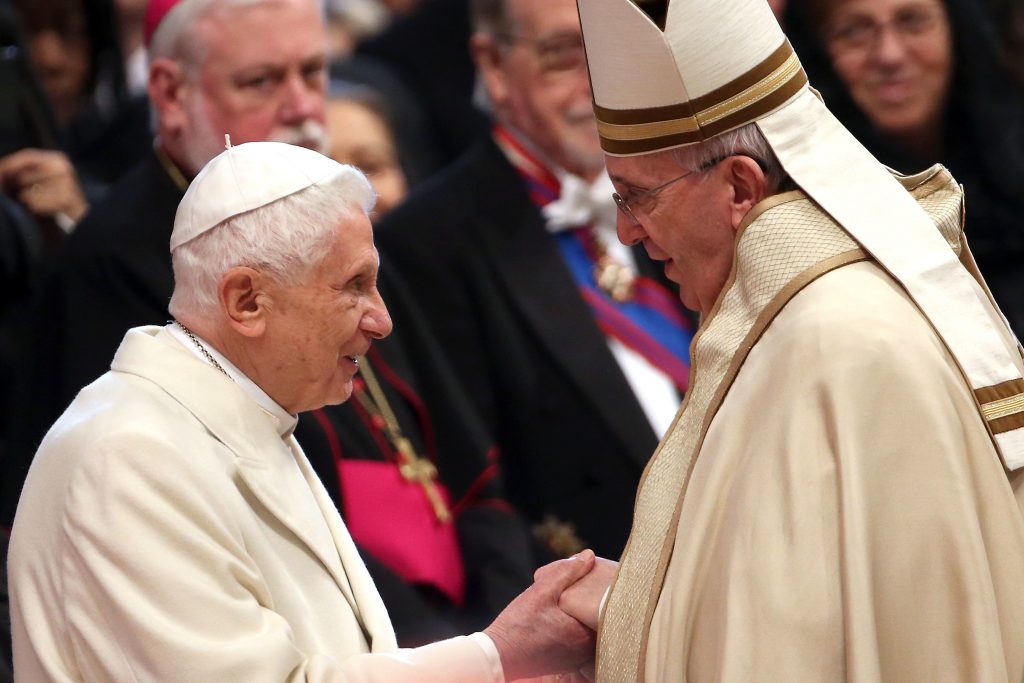In popular media narratives, it’s long been taken for granted that Pope Francis marks, if not a repudiation, certainly a dramatic break with his predecessor, Pope Emeritus Benedict XVI. Yet recently, the argument for continuity between the two pontiffs drew unexpected boosts from two different quarters — one having to do with Vatican foreign policy and the other Catholic liturgy.
Jesuit Father Federico Lombardi recently published an article in La Civiltà Cattolica, the Jesuit-edited journal that enjoys a sort of semiofficial Vatican standing, on the 10th anniversary of a letter by Pope Benedict XVI to Chinese Catholics. The gist was that Pope Francis shares the vision laid out in that letter and, because of certain personal and biographical advantages, may be positioned to move the ball.
Among those advantages, Father Lombardi suggested, are that Pope Francis is not European, he’s never been involved in a direct conflict with communism and, as a Jesuit, he stands in the tradition of great Jesuit pioneers, such as Matteo Ricci and Adam Schall, whose memories are still venerated in China today.
Father Lombardi said that Pope Benedict’s letter “placed the unity of the Church at the forefront, and indicated the way to accomplish it in communion, charity and willingness [is] to adopt concrete and reciprocal attitudes of mercy and reconciliation at the various levels of ecclesial life, among bishops, priests and faithful,” adding that Pope Francis is in “clear continuity” with that approach.
When Father Lombardi emphasizes the case for continuity between Pope Benedict and Pope Francis, he brings considerable personal credibility.
Not only did he serve Pope Benedict tirelessly as his public spokesman, interpreting the mind of the pope for the world, but today he heads the Fondazione Vaticana Joseph Ratzinger-Benedetto XVI, popularly known as the Fondazione Ratzinger, dedicated to promoting study of Pope’s Benedict’s theological works. Yet as a Jesuit, Father Lombardi is also close to Pope Francis, meaning he represents a sort of living continuity between the two papacies.
If anything, liturgy is arguably an even more unlikely arena in which to detect continuity between Pope Benedict and Pope Francis.
Aside from the fact that the fine points of worship are simply much closer to Pope Benedict’s heart than Pope Francis’, the Argentine pontiff recently took a step that many saw as a clear break with his German predecessor, revising parts of a 2001 Vatican ruling called “Liturgiam Authenticam” (“On the Use of Vernacular Languages in Publication of the Books of the Roman Liturgy”), which centralized control over the translation of liturgical texts in Rome and mandated a more literal rendering of the Latin originals.
That document came out under St. John Paul II, but was strongly supported by Cardinal Joseph Ratzinger, the future Pope Benedict, who continued to apply it during his papacy.
Now, Pope Francis has decreed that most of the control over the translation process will pass to the bishops’ conferences, and it will be the bishops, not the Vatican, who will make judgments as to whether a particular translation is faithful.
Pope Francis clearly means for that approach to stick. In November, he took the unusual step of writing a public letter to Cardinal Robert Sarah of Guinea, who heads the Congregation for Divine Worship, responding to comments Cardinal Sarah had made suggesting the Vatican could still “impose” certain elements of translations. In effect, the pope told him that’s not what his ruling means at all.
Yet on Nov. 3, Pope Francis basically took Pope Benedict’s side in arguably the single most contentious liturgical debate of them all over the last 20 years, insisting that “for many” is the right way to express those for whom Christ died, rather than the alternative “for all.”
“The ‘many’ who will rise for eternal life are to be understood as the ‘many’ for whom the blood of Christ was shed,” Pope Francis said during a Mass for cardinals who had died during the past year.
He argued that “for many” better captures the idea that human beings find themselves before a “crossroads,” leading either toward or away from God, and while the former will reap eternal life, the latter will find “eternal shame.”
It’s not clear what those statements may mean from a policy point of view — whether Pope Francis will insist that bishops’ conferences translate the phrase that way across the board or allow them to make the decision for themselves, which appears to be the spirit of his recent edict.
It may not be utterly coincidental that Pope Francis made his statements not long after Cardinal Reinhard Marx of Germany, having expressed “huge relief” that “Liturgiam Authenticam” is now a “dead end,” suggested the German bishops may take advantage of Pope Francis’ new rules to maintain “for all” in their translation of the Mass.
Perhaps this was an indirect way for Pope Francis to say, “Not so fast.” At a minimum, it suggests that on at least one front in the notorious “liturgy wars,” the two pontiffs are in sync.
None of this is to deny, of course, that there are obvious contrasts between Pope Benedict and Pope Francis, both in style and substance. For one thing, perhaps the single most important thing any pope will ever do to shape the future of the Church is the kind of bishops he appoints, and it would be silly to contend that precisely the same men being tapped under Pope Francis also would have ascended under Pope Benedict.
In other words, Pope Benedict and Pope Francis share some things, and differ on others. Probably a cursory review of the history of the papacy would suggest it’s pretty much always been thus.
We’ll have to wait to draw a final balance on how much unites Pope Benedict and Pope Francis, and how much distinguishes them. When it’s time for that exercise, however, early November 2017 may be remembered as a point in which the case for continuity staged a comeback.

